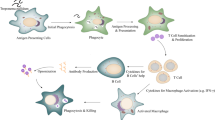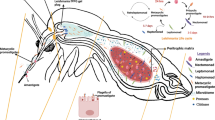Abstract
Opisthorchis viverrini infection is endemic in the lower Mekong subregion. The liver is an organ that worms are drawn to and cause damage. However, the immune-related susceptibility in the liver is poorly understood. In this study, we investigated T helper (Th) cell responses in the liver of BALB/c mice and golden Syrian hamsters during 2–28 days post-infection (DPI). We found that Th cell responses were distinct between mice and hamsters in terms of dynamics and polarization. Mice exhibited the early induction of Th1, Th2, Th17, and regulatory T (Treg) cells responses after the presence of O. viverrini worms at 2 DPI. In hamsters, the late induction of Th1/Th17, downregulation of Th2/Treg responses and early elevation of suppressive cytokine interleukin (IL)-10 were found together with swift reduction of Th cell numbers. Interestingly, expressions of IL-4 (Th2 functional cytokine) and Foxp3 (Treg lineage) were completely different between mice and hamsters which elevated in mice but suppressed in hamsters. These results suggest that early induction and well-regulation are related to host resistance. In contrast, late induction of Th cell response might allow immature worms to develop in the host. Our findings provide a greater understanding in Th cell response-related susceptibility in O. viverrini infection which would be targeting immunity for the development of immune-based intervention such as vaccine.





Similar content being viewed by others
Data availability
The authors confirm that the data supporting the findings of this study are available within the article.
References
Bancroft AJ, Artis D, Donaldson DD, Sypek JP, Grencis RK (2000) Gastrointestinal nematode expulsion in IL-4 knockout mice is IL-13 dependent. Eur J Immunol 30(7):2083–2091. https://doi.org/10.1002/1521-4141(200007)30:7%3c2083::AID-IMMU2083%3e3.0.CO;2-3
Boonmars T, Boonjaraspinyo S, Kaewsamut B (2009) Animal models for Opisthorchis viverrini infection. Parasitol Res 104(3):701–703. https://doi.org/10.1007/s00436-008-1268-x
Corripio-Miyar Y, Hayward A, Lemon H, Sweeny AR, Bal X, Kenyon F, Pilkington JG, Pemberton JM, Nussey DH, McNeilly TN (2022) Functionally distinct T-helper cell phenotypes predict resistance to different types of parasites in a wild mammal. Sci Rep 12(1):3197. https://doi.org/10.1038/s41598-022-07149-9
Dangtakot R, Pinlaor S, Itthitaetrakool U, Chaidee A, Chomvarin C, Sangka A, Wilailuckana C, Pinlaor P (2017) Coinfection with Helicobacter pylori and Opisthorchis viverrini enhances the severity of hepatobiliary abnormalities in hamsters. Infect Immun 85(4):e00009-17. https://doi.org/10.1128/IAI.00009-17
Finkelman FD, Urban JF Jr, Beckmann MP, Schooley KA, Holmes JM, Katona IM (1991) Regulation of murine in vivo IgG and IgE responses by a monoclonal anti-IL-4 receptor antibody. Int Immunol 3(6):599–607. https://doi.org/10.1093/intimm/3.6.599
Hammerbeck CD, Hooper JW (2011) T cells are not required for pathogenesis in the syrian hamster model of hantavirus pulmonary syndrome. J Virol 85(19):9929–9944. https://doi.org/10.1128/JVI.05356-11
Horsnell WG, Cutler AJ, Hoving JC, Mearns H, Myburgh E, Arendse B, Finkelman FD, Owens GK, Erle D, Brombacher F (2007) Delayed goblet cell hyperplasia, acetylcholine receptor expression, and worm expulsion in SMC-specific IL-4Rα–deficient mice. PLoS Pathog 3(1):e1. https://doi.org/10.1371/journal.ppat.0030001
Jittimanee J, Sermswan RW, Puapairoj A, Maleewong W, Wongratanacheewin S (2007) Cytokine expression in hamsters experimentally infected with Opisthorchis viverrini. Parasite Immunol 29(3):159–167. https://doi.org/10.1111/j.1365-3024.2006.00929.x
Jittimanee J, Sermswan RW, Kaewraemruaen C, Barta JR, Macinnes JI, Maleewong W, Wongratanacheewin S (2012) Protective immunization of hamsters against Opisthorchis viverrini infection is associated with the reduction of TGF-β expression. Acta Trop 122(2):189–195. https://doi.org/10.1016/j.actatropica.2012.01.010
Jones DE, Elloso MM, Scott P (1998) Host susceptibility factors to cutaneous leishmaniasis. Front Biosci 3:D1171–D1180. https://doi.org/10.2741/A353
Kaewraemruaen C, Sermswan RW, Wongratanacheewin S (2016) Induction of regulatory T cells by Opisthorchis viverrini. Parasite Immunol 38(11):688–697. https://doi.org/10.1111/pim.12358
Maizels RM, Yazdanbakhsh M (2003) Immune regulation by helminth parasites: cellular and molecular mechanisms. Nat Rev Immunol 3(9):733–744. https://doi.org/10.1038/nri1183
Mangiafico SS (2023) rcompanion: functions to support extension education program evaluation. Rutgers Cooperative Extension, New Brunswick, New Jersey. version 2.4.34. https://CRAN.R-project.org/package=rcompanion/
Marillier RG, Michels C, Smith EM, Fick LC, Leeto M, Dewals B, Horsnell WG, Brombacher F (2008) IL-4/IL-13 independent goblet cell hyperplasia in experimental helminth infections. BMC Immunol 9:11. https://doi.org/10.1186/1471-2172-9-11
Ninlawan K, O’Hara SP, Splinter PL, Yongvanit P, Kaewkes S, Surapaitoon A, LaRusso NF, Sripa B (2010) Opisthorchis viverrini excretory/secretory products induce toll-like receptor 4 upregulation and production of interleukin 6 and 8 in cholangiocyte. Parasitol Int 59(4):616–621. https://doi.org/10.1016/j.parint.2010.09.008
Nithikathkul C, Tesana S, Sithithaworn P, Balakanich S (2007) Early stage biliary and intrahepatic migration of Opisthorchis viverrini in the golden hamster. J Helminthol 81(1):39–41. https://doi.org/10.1017/S0022149X07212106
R Core Team (2022) R: a language and environment for statistical computing. R Foundation for Statistical Computing, Vienna, Austria. https://www.R-project.org/
Riganti M, Pungpak S, Punpoowong B, Bunnag D, Harinasuta T (1989) Human pathology of Opisthorchis viverrini infection: a comparison of adults and children. Southeast Asian J Trop Med Public Health 20(1):95–100
Schopf LR, Hoffmann KF, Cheever AW, Urban JF Jr, Wynn TA (2002) IL-10 Is critical for host resistance and survival during gastrointestinal helminth infection. J Immunol 168(5):2383–2392. https://doi.org/10.4049/jimmunol.168.5.2383
Shi W, Wei ZY, Elsheikha HM, Zhang FK, Sheng ZA, Lu KJ, Wang DY, Huang WY, Zhu XQ (2017) Dynamic expression of cytokine and transcription factor genes during experimental Fasciola gigantica infection in buffaloes. Parasit Vectors 10(1):602. https://doi.org/10.1186/s13071-017-2538-1
Sripa B, Kaewkes S (2000a) Localisation of parasite antigens and in¯ammatory responses in experimental opisthorchiasis. Int J Parasitol 30(6):735–740. https://doi.org/10.1016/s0020-7519(00)00054-0
Sripa B, Kaewkes S (2000b) Relationship between parasite-specific antibody responses and intensity of Opisthorchis viverrini infection in hamsters. Parasite Immunol 22(3):139–145. https://doi.org/10.1046/j.1365-3024.2000.00286.x
Suwannatrai A, Saichua P, Haswell M (2018) Epidemiology of Opisthorchis viverrini infection. Adv Parasitol 101:41–67. https://doi.org/10.1016/bs.apar.2018.05.002
Suyapoh W, Tirnitz-Parker JEE, Tangkawattana S, Suttiprapa S, Sripa B (2021) Biliary migration, colonization, and pathogenesis of O. viverrini co-infected with CagA+ Helicobacter pylori. Pathogens 10(9):1089. https://doi.org/10.3390/pathogens10091089
Thongrin T, Suyapoh W, Wendo W, Tangkawattana P, Sukon P, Salao K, Suttiprapa S, Saichua P, Tangkawatana S (2023) Inflammatory cell responses in biliary mucosa during Opisthorchis viverrini infection: insights into susceptibility differences among hosts. Open Vet J 13(9):1150–1166. https://doi.org/10.5455/OVJ.2023.v13.i9.11
Turner JD, Meurs L, Dool P, Bourke CD, Mbow M, Dièye TN, Mboup S, Polman K, Mountford AP (2013) Schistosome infection is associated with enhanced whole-blood IL-10 secretion in response to cercarial excretory/secretory products. Parasite Immunol 35(5–6):147–156. https://doi.org/10.1111/pim.12028
Upontain S, Sereerak P, Laha T, Sripa B, Tangkawatana P, Brindley PJ, Tangkawatana S (2018) Granulin expression in hamsters during Opisthorchis viverrini infection-induced cholangiocarcinogenesis. Asian Pac J Cancer Prev 19(9):2437–2445. https://doi.org/10.22034/APJCP.2018.19.9.2437
Urban JF Jr, Katona IM, Paul WE, Finkelman FD (1991) Interleukin 4 is important in protective immunity to a gastrointestinal nematode infection in mice. Proc Natl Acad Sci U S A 88(13):5513–5517. https://doi.org/10.1073/pnas.88.13.5513
Watakulsin K, Surapaitoon A, Ulag LH, Kaing S, Suyapoh W, Saichua P, Salao K, Tangkawatana S, Suttiprapa S (2023) Distinct antibody response in susceptible and non-susceptible hosts of the carcinogenic liver fluke Opisthorchis viverrini infection. Parasitology 150(8):653–660. https://doi.org/10.1017/S0031182023000112
Webster HC, Gamino V, Andrusaite AT, Ridgewell OJ, McCowan J, Shergold AL, Heieis GA, Milling SWF, Maizels RM, Perona-Wright G (2022) Tissue-based IL-10 signalling in helminth infection limits IFNγ expression and promotes the intestinal Th2 response. Mucosal Immunol 15(6):1257–1269. https://doi.org/10.1038/s41385-022-00513-y
Wickham H (2016) ggplot2: elegant graphics for data analysis. Springer-Verlag, New York
Wickham H and Seidel D (2022) scales: scale functions for visualization. R package version version 1.2.1. https://CRAN.R-project.org/package=scales
Wongratanacheewin S, Rattanasiriwilai W, Priwan R, Sirisinha S (1987) Immunodepression in hamsters experimentally infected with Opisthorchis viverrini. J Helminthol 61(2):151–156. https://doi.org/10.1017/S0022149X00009913
Yan C, Zhang BB, Hua H, Li B, Zhang B, Yu Q, Li XY, Liu Y, Pan W, Liu XY, Tang RX, Zheng KY (2015) The dynamics of Treg/Th17 and the imbalance of Treg/Th17 in Clonorchis sinensis-infected mice. PLoS One 10(11):e0143217. https://doi.org/10.1371/journal.pone.0143217
Zaph C, Cooper PJ, Harris NL (2014) Mucosal immune responses following intestinal nematode infection. Parasite Immunol 36(9):439–452. https://doi.org/10.1111/pim.12090
Zhang BB, Yan C, Fang F, Du Y, Ma R, Li XY, Yu Q, Meng D, Tang RX, Zheng KY (2017) Increased hepatic Th2 and Treg subsets are associated with biliary fibrosis in different strains of mice caused by Clonorchis sinensis. PLoS One 12(2):e0171005. https://doi.org/10.1371/journal.pone.0171005
Acknowledgements
The authors would like to thank Professors Banchob Sripa and Yukifumi Nawa for their invaluable guidance throughout this study. The author would like to thank all staffs of the Northeast Laboratory Animal Center and the Animal Laboratory Unit, Faculty of Medicine, Khon Kaen University, who supported in animal experiments.
Funding
This research was supported by the Fundamental Fund of Khon Kaen University and the National Science, Research and Innovation Fund (NSRF)-FF2565. Pattaraporn Srisai was supported by a Postgraduate Study Support Grant of Faculty of Medicine, Khon Kaen University.
Author information
Authors and Affiliations
Contributions
Pattaraporn Srisai performed the experiments, data analysis and interpretation, and wrote the manuscript. Sujittra Chaiyadet and Amonrat Jumnainsong contributed to data interpretation, designed the experiments, and reviewed and edited the manuscript. Sutas Suttiprapa contributed to data interpretation and edited the manuscript. Chanvit Leelayuwat contributed to conceptual discussions and reviewed and edited the manuscript. Prasert Saichua initiated the conception and design of the research study, performed the experiments and data interpretation, and revised and edited the manuscript. All authors read and approved the final manuscript.
Corresponding author
Ethics declarations
Ethical approval
Protocols for experimental practices of hamsters and mice in this study were approved by animal ethics committees of Northeast Laboratory Animal Center, Khon Kaen. The approval code is IACUC-KKU-70/64.
Consent to participate
Not applicable.
Consent for publication
Not applicable.
Competing interests
The authors declare no competing interests.
Additional information
Handling Editor: Una Ryan
Publisher's Note
Springer Nature remains neutral with regard to jurisdictional claims in published maps and institutional affiliations.
Supplementary Information
Below is the link to the electronic supplementary material.
Rights and permissions
Springer Nature or its licensor (e.g. a society or other partner) holds exclusive rights to this article under a publishing agreement with the author(s) or other rightsholder(s); author self-archiving of the accepted manuscript version of this article is solely governed by the terms of such publishing agreement and applicable law.
About this article
Cite this article
Srisai, P., Chaiyadet, S., Jumnainsong, A. et al. T helper cell responses to Opisthorchis viverrini infection associate with host susceptibility. Parasitol Res 123, 135 (2024). https://doi.org/10.1007/s00436-024-08154-9
Received:
Accepted:
Published:
DOI: https://doi.org/10.1007/s00436-024-08154-9




